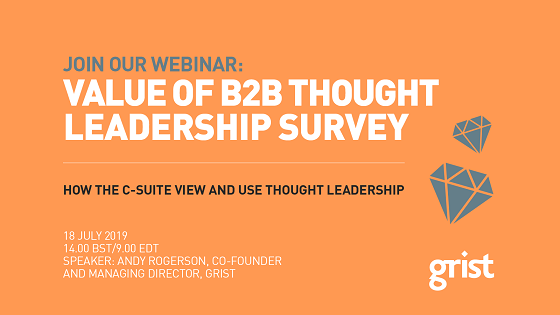When we hosted an event exploring the results from our latest research on the value of thought leadership in B2B, it provoked an engaged and thought-provoking discussion.
Grist’s co-founder and managing director Andrew Rogerson took attendees – including senior decision-makers from Barclays, Slaughter and May, State Street, Proskauer, Oracle Netsuite and Gowling WLG – through some of the key findings from our research into how the C-suite view and use thought leadership. The research is based on views from more than 500 enterprise firms in the US, Europe and Asia.
Our survey says… keep these four things in mind before embarking on thought leadership
Our research found four emerging thought leadership key themes in 2019. They influence question and survey design as well as outcomes and distribution methods, so be sure to consider them in your thought leadership strategy.
The rise of data
Unsurprisingly in this era of fake news and hijacked algorithms, business leaders want their fresh thinking backed up by reliable data. Robust data is the most sought-after quality in thought leadership (44%), up from 29% in 2016. This is likely driven by the glut of noise in content today – people producing content for the sake of it. That some of this noise is branded as thought leadership has impacted the way thought leadership is considered in some quarters.
This is where a mix of both qualitative and quantitative data can help make thought leadership stand out from the crowd. Data can miss context, so you need both analysis of what that data means and the thoughts of those who shared their views.
What surprised those around the table, though, were the findings around survey size: it seems it’s quality over quantity, and big survey numbers won’t necessarily impress readers. The quantity of responses ranks last in the quality most likely to inspire trust in thought leadership (39%), whereas the quality of analysis comes top (60%).
State Street’s head of EMEA insights James Redgrave agreed that both quantitative and qualitative insights are needed – that numbers are not necessarily as important if you’ve conducted some insightful interviews with the right people. However, Robert Ratcliff, head of content at Barclays, said thought leadership is often driven by PR, with the press often needing at least 500 responses before they’ll touch it.
Angela Pitsillides, national head of marketing and communications at Crowe, also acknowledged that this can be a challenge for those developing thought leadership. Consider the ultimate aim: if press coverage is your objective you may need a larger sample for it to pique the interest of journalists than if your aim is to use the thought leadership to start conversations with prospects.
Has Trump impacted thought leadership?
The need for data to back up opinion is arguably in part to Brexit and Trump-style politics. When everything we read is full of pomp and bluster, of style over substance, how do we know what to believe?
Although robust data was the most valuable quality in thought leadership, it was closely followed by fresh thinking (41%) –exploring issues or challenges from new and different perspectives – and genuine insight and informed opinion to influence thinking (39%).
More than ever, we must pay close attention to the information we issue under our brand names as it will likely be looked at with suspicion and could be torn apart. Relationships and reputations are under ever-increasing scrutiny, and, once lost, that audience is difficult to win back. Make your thought leadership robust by asking the right questions of the right people and present the data with informed and fresh analysis that highlights expertise in the field.
The need for accessibility and relatability
Don’t assume the C-suite just wants to hear from people like them. Our survey found that the customer viewpoint was the most important to thought leadership (62% of respondents).
David Turner, EMEA marketing director at Oracle Netsuite believes the size of a company may alter who they most want to hear from. According to Turner, the customer viewpoint becomes more sought after as a business gets bigger. Smaller companies are closer to their customers and therefore prefer to hear from peers to gauge industry best practice and competitor movements. However, bigger companies are more removed from their customers and subsequently need that viewpoint more.
Our survey found that, while customer views are still top for the C-suite, the views of peers (48%) and industry experts (44%) are close behind. What’s more, the desire to hear from inspirational individuals outside the industry is also noticeable (41%). The C-suite wants to step out of the silo and get outside perspectives, which can be useful when developing thought leadership.
Where thought leadership fits into the sales process
In the past, thought leadership was always seen as a brand-building activity, but changes in buyer behavior and the ability to track prospects using marketing automation has meant it has now become an essential tool in the sales kit.
Good thought leadership can enable sales if handled right. Our survey found that thought leadership adds the most value to the C-suite at the middle of the sales process, and specifically, to discover solutions (39%) or to research an issue (17%).
Those views were echoed by our attendees, who felt thought leadership is much more commercially focused today. Angela Pitsilldes wasn’t surprised by the research findings, saying that although thought leadership should always be of value to the reader, it should also help drive sales. However, thought leadership can still be used early in the sales process too. For example, Charlotte Irving, marketing manager at Thomsons Online Benefits, said they typically use thought leadership as a top of funnel piece – something to attract attention rather than accelerate conversion – using more product specific content further down the funnel.
Thought leadership can be a great sales enabler, but where and how it fits into the overall process needs careful consideration.
If you missed our roundtable series but would like to find out more, join our webinar on the 18th of July 2019, 2pm BST.



